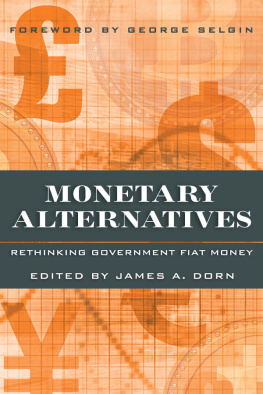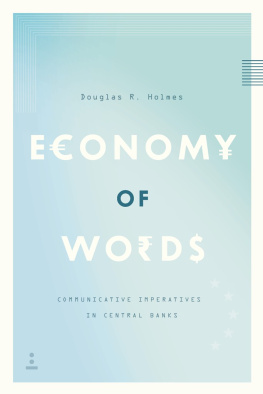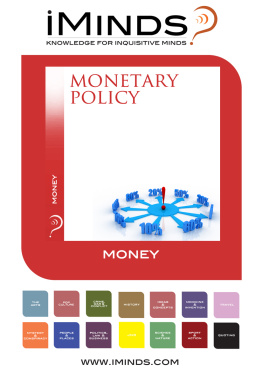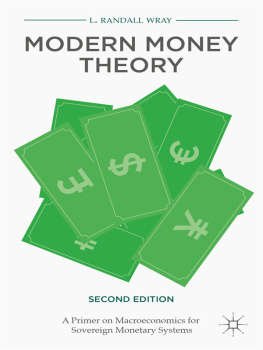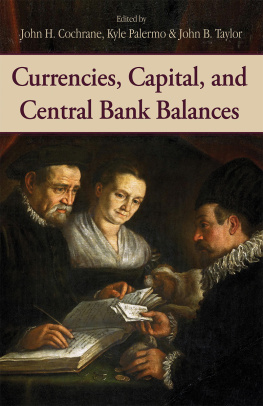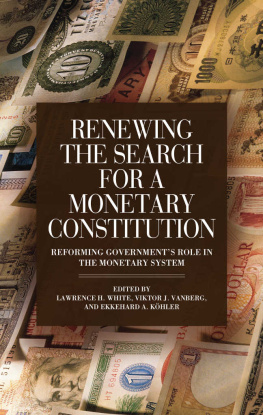MONETARY ALTERNATIVES
RETHINKING GOVERNMENT FIAT MONEY
Edited by
James A. Dorn
Copyright 2017 by the Cato Institute
All rights reserved
ISBN: 978-1-944424-44-2
eBook ISBN: 978-1-944424-45-9
Library of Congress Cataloging-in-Publication Data available.
Printed in the United States of America
Cover design: Jon Meyers
Cato Institute
1000 Massachusetts Avenue, N.W.
Washington, D.C. 20001
www.cato.org
CONTENTS
George Selgin
Chapter 1 INTRODUCTION
Toward a New Monetary Regime
James A. Dorn
Claudio Borio
Jeffrey M. Lacker
John A. Allison
Bennett T. McCallum
Richard H. Timberlake
James M. Buchanan
Peter Bernholz
Charles I. Plosser
George Selgin
John B. Taylor
Scott B. Sumner
Leland B. Yeager
Edwin Vieira Jr.
Lawrence H. White
Roland Vaubel
Lawrence H. White
Kevin Dowd
George Selgin
My, things have changed! In 1986, when the earliest of the papers gathered here first appeared in print, interest in alternatives to government fiat money was already limited to a small setnot to say a fringeof monetary economists and policymakers. Subsequent events only tended to reduce that interest still further. Paul Volckers Fed had managed to rein inflation back to a modest level last seen in the 1960s. On the heels of that success came the Great Moderationa decline in the severity of business cycle fluctuations that many experts, after a decade or so, considered permanent. By 2000 Alan Greenspan, who had presided over most of that moderation, had been dubbed the Maestro. So far as Fed officials and many academic economists were concerned, after three quarters of a century of stumbling, the Federal Reserve System had at last found its sea legs. If it wasnt the best of all possible monetary systems, surely it was close enough.
Subsequent events have left that confident view in tatters. The Great Moderation ended, suddenly and harrowingly, with the outbreak of the 2008 financial crisis. The accompanying Great Recession was, among all U.S. downturns, second only to the Great Depression itself in its overall severity. In responding to it, the Federal Reserve found it necessary to altogether abandon its traditional methods of monetary policythe stirrups and reins that saw it through the glory days of the 1980s and 90sin favor of untested alternatives.
To say that those alternatives failed to bring about a rapid, or even a complete, recovery from the crisis, is putting things diplomatically. The unvarnished truth is that disappointment with the Feds post-crisis experimentsand also with its handling of the crisis itselfhave raised doubts concerning its ability to perform the duties Congress has assigned to it.
To appreciate the Feds shortcomings is one thing; to propose ways to improve upon it is quite another. The complacency wrought by the Great Moderation, not to mention the limited interest in fundamental monetary reform before then, resulted in a dearth of serious inquiries into potentially superior arrangements. The Cato Institute was, until recently, practically alone among think tanks in stepping into the breach. Throughout the 1980s and 90s, while journalists and most academic economists celebrated the Feds mastery of scientific monetary management, and other think tanks avoided the topic of monetary reform, Cato kept the subject alive, offering a safe haven, in the shape of its Annual Monetary Conference, for the minority of experts that continued to stress the need for fundamental monetary reform.
Although fundamental reform has been a consistent theme of Catos monetary conferences, those conferences have never been dominated by any one approach to reform. The articles in this book present a variety of ideas for improving the monetary regimeincluding proposals for a formal monetary constitution, various monetary rules, competing currencies, and establishing a new gold standard. The intent of the conferences has always been to encourage serious discussion of not one but many possible alternatives to discretionary government fiat money. The same purpose also informed the establishment and naming, in 2014, of Catos Center for Monetary and Financial Alternatives.
Any idea for fundamental reform is bound to be controversial; and the proposals offered here are certainly no exception. Their authors do not agree with one another, and neither I nor Jim Dorn nor anyone else at Cato agreesor could possibly agreewith all of them. But while Im not inclined to agree with, much less to defend, all of the ideas put forward here, I do want to counter the suggestion that proposals for doing away with the Fed, or fiat money, or both, amount to a plea to roll back the clock to some bygone era. Just as theres nothing new under the sun, there are few ideas for monetary reform that might not have this complaint hurled at them. Champions of the Federal Reserve Act might, for example, have been accused of attempting to turn back the clock to the days of the Second Bank of the United States. Of course the complaint would have been fatuous, because the Fed, whatever its shortcomings, was not simply a replica of the Second Bank of the United States.
Similarly, while some of the alternatives proposed here, and especially those that recommend dispensing with the Fed, or establishing a new gold standard, or both, are necessarily informed by past experience, it doesnt follow that their authors regard any past arrangement as ideal, let alone as an ideal that can be replicated today. In proposing sometimes radical departures from the status quo, their aim is, not to reverse genuine progress, but to help us move beyond a system that has repeatedly, and often cataclysmically, failed to deliver the stability its champions promised.
When the Federal Reserve was created in 1913, its powers were strictly limited and the United States was still on the gold standard. Today the Fed has virtually unlimited power and the dollar is a pure fiat money.
A limited constitutional government calls for a rules-based, free-market monetary system, not the topsy-turvy fiat dollar that now exists under central banking. This book examines the case for alternatives to discretionary government fiat money and the reforms needed to move toward free-market money.
Central banking, like any sort of central planning, is not a panacea. Concentrating monetary power in the hands of a few individuals within a government bureaucracy, even if those individuals are well intentioned and well educated, does not guarantee sound money. The worlds most important central bank, the Federal Reserve, is not bound by any strict rules, although Congress requires that it achieve maximum employment and price stability. The failure of the Fed to prevent the Great Recession of 2009, the Great Depression of the 1930s, and the stagflation of the late 1970s and early 1980s raises the question, can we do better?
In questioning the status quo and widening the scope of debate over monetary reform, the fundamental issue is to contrast a monetary regime that is self-regulating, spontaneous, and independent of government meddling versus one that is centralized, discretionary, politicized, and has a monopoly on fiat money. Free-market money within a trusted network of private contracts differs fundamentally from an inconvertible fiat money supplied by a discretionary central bank that has the power to create money out of thin air and to regulate both banks and nonbank financial institutions.

